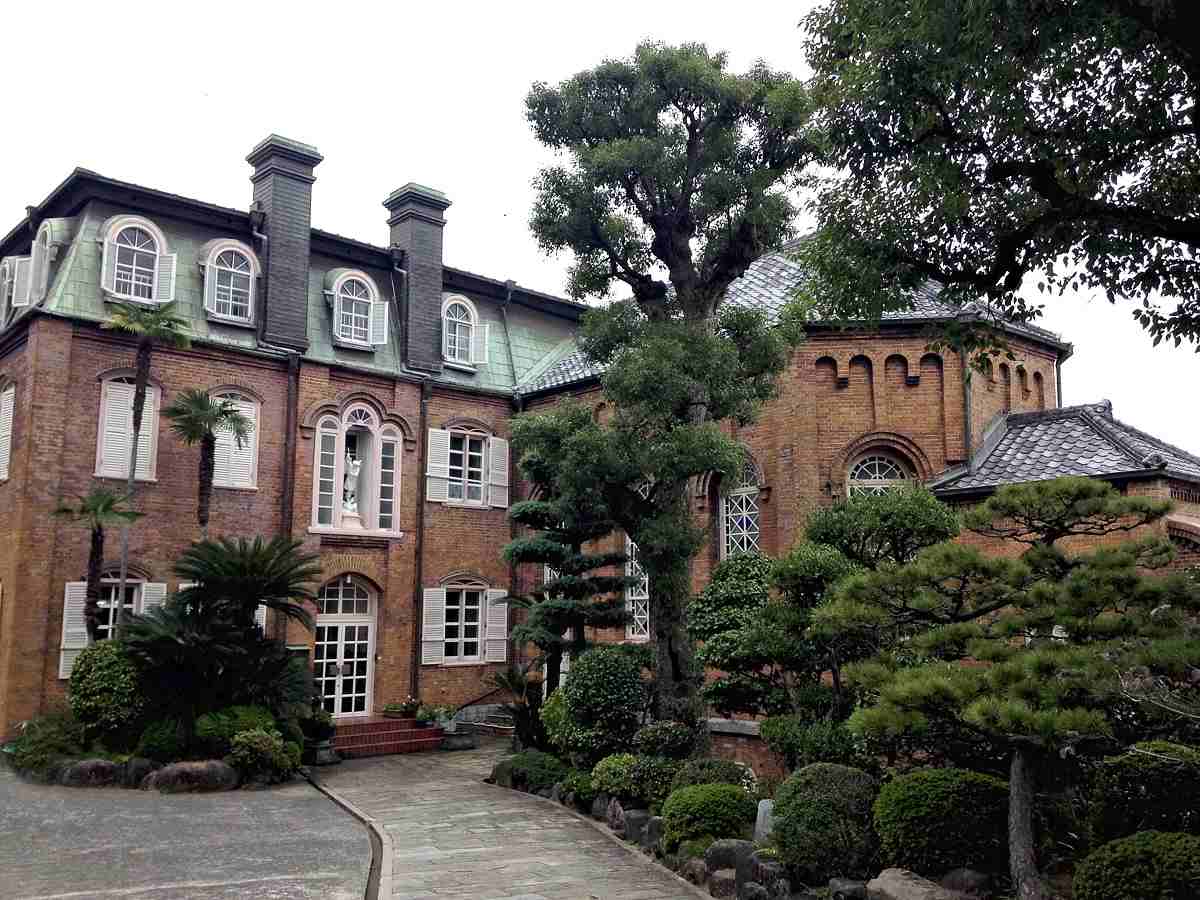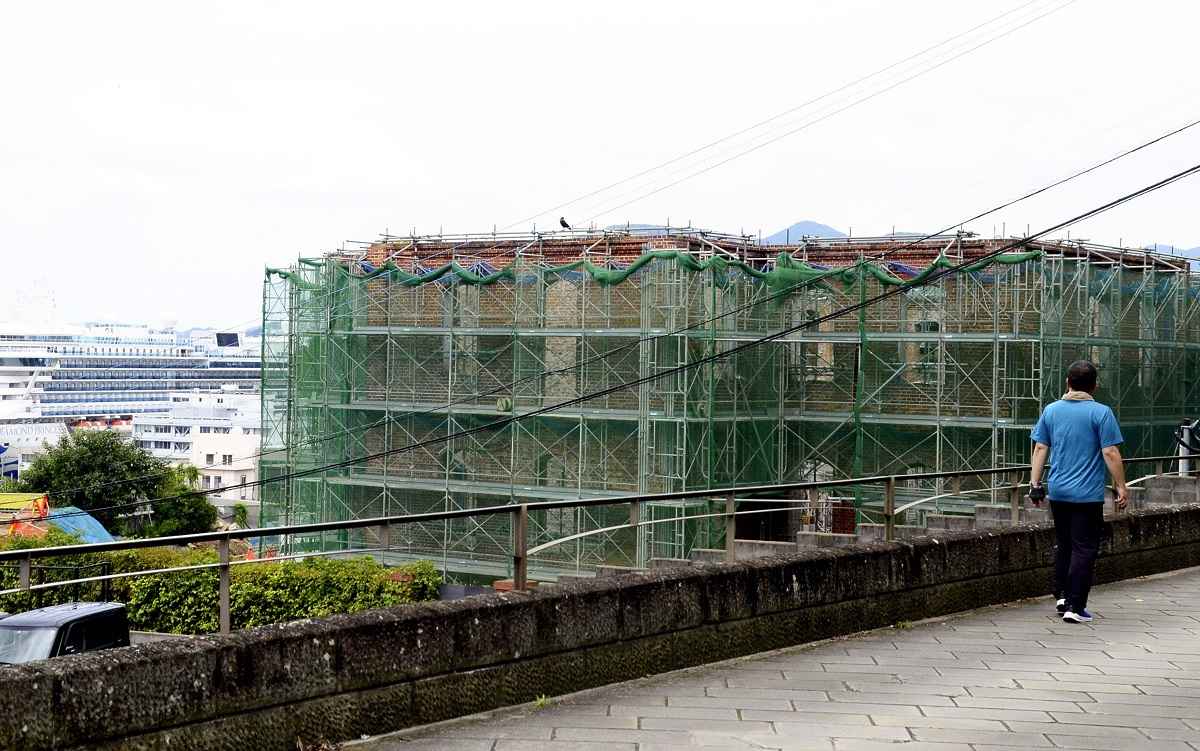
The red-brick former Maria-en building in 2016.
13:33 JST, August 8, 2023
NAGASAKI — A building that survived the 1945 atomic bombing of Nagasaki, which was later used as Maria-en orphanage, is being refurbished into a luxury hotel.
As people who survived the bombing are now well into old age, buildings that survived it have become increasingly important as “silent storytellers.”
Even so, some buildings have been demolished due to the high cost of maintaining them as they become old.
In light of this situation, an expert says that both the public and private sectors need to step up efforts to preserve and utilize these buildings.
19th-century edifice
In late July, renovation work was underway on the former Maria-en building in the city’s Minami-Yamate district, on a hill overlooking Nagasaki Port. Gaps in the scaffolding’s netting revealed glimpses of red brick walls that had been standing since before the time of the atomic bombing.
The renovation work is being conducted by Tokyo-based real estate developer Mori Trust Co. The renovated building will become the Hotel Indigo Nagasaki Glover Street, to be operated by InterContinental Hotels Group, a British company. The hotel is expected to open in late 2024.
“We will preserve the historically and culturally one-of-a-kind building for the future,” Mori Trust President Miwako Date said, explaining the significance of the project.
According to the Nagasaki municipal government, the former Maria-en building was built as a convent in 1898, designed by a French monk. It is a three-story Romanesque building with arched window frames. The Sainte Enfance de Nagasaki orphanage, the predecessor to the Maria-en, was also housed in the building in 1899.
During World War II, a district guard unit was headquartered in the building. It is said that most of its windows were broken by the blast from the atomic bombing of Nagasaki.
After the end of the war, a Canadian nun began sheltering war orphans and children returning from long-term evacuation, and the children’s home made a fresh start with the Maria-en name. In 2019, the children’s home was moved to a nearby location due to the aging of the building. Facility head Ya- suhiro Akaiwa, 72, said: “The former Maria-en is a symbol of the community inherited from former generations. I am relieved that the building will be preserved.”
However, this is actually a rare case.
In 1992, the Nagasaki city government set criteria for the handling of surviving A-bombed buildings and other objects, with the aim of conveying the reality of the atomic bombing to future generations. The criteria, which apply to bridges and trees as well as buildings, classify items from A to D based on the degree of traces left and their state of use at the time of the bombing. Maria-en was ranked D for least damaged, in 1998.
While the municipal government has a program to subsidize the cost of preservation work by up to ¥30 million, the program only covers buildings ranked A or B, such as a severely damaged building of the former Shiroyama National School. Of 133 buildings, structures and other objects ranked A to D, 21 have been demolished for reasons such as aging and urban development projects.

Renovation work is seen underway on July 21 at the former Maria-en orphanage in the Minami-Yamate district of Nagasaki City, overlooking Nagasaki Port. A massive cruise ship is seen in the background.
Broad discussion needed
For some buildings that were exposed to the atomic bomb, opinions are divided over whether to preserve them or demolish them. The D-ranked former Nagasaki Police Station, later used as annex No. 3 of the former prefectural government building, is one example. The Nagasaki prefectural government, which owns the building, is conducting surveys to discover any demand or possible uses for the building. It will reach a conclusion while also taking into account the policy direction of the use of the entire former prefectural government site, earthquake retrofitting costs and other factors.
Meanwhile, the average age of hibakusha A-bomb survivors has exceeded 85 for the first time. Seiichiro Mise, 88, who has been telling the story of his atomic bombing experience, said: “Soon, there will be no hibakusha who can talk about their own A-bomb experience. I hope the preciousness of peace will be taught to coming generations through valuable buildings that tell the reality of the atomic bombing.”
Norioki Ishimaru, 82, a former professor of urban development at Hiroshima University who is familiar with buildings that survived an A-bombing, said: “Buildings have a life span. As safety must be secured, preserving all of the buildings through only the efforts of owners and subsidies of municipalities would be difficult.
“It is necessary for people from various fields, including private businesses, to think together and discuss preservation methods that are suited to the current era. It is also important for municipalities to take the lead in disseminating information about buildings that survived the A-bomb to increase interest in them.”
"Society" POPULAR ARTICLE
-

M4.9 Earthquake Hits Tokyo, Neighboring Prefectures
-

Israeli Tourists Refused Accommodation at Hotel in Japan’s Nagano Pref., Prompting Protest by Israeli Embassy and Probe by Prefecture
-

M7.5 Earthquake Hits Northern Japan; Tsunami Waves Observed in Hokkaido, Aomori and Iwate Prefectures
-

Tsukiji Market Urges Tourists to Avoid Visiting in Year-End
-

High School in Kyoto Says Students Shoplifted during Recent School Trip to Bali, Indonesia
JN ACCESS RANKING
-

Tokyo Economic Security Forum to Hold Inaugural Meeting Amid Tense Global Environment
-

Keidanren Chairman Yoshinobu Tsutsui Visits Kashiwazaki-Kariwa Nuclear Power Plant; Inspects New Emergency Safety System
-

Imports of Rare Earths from China Facing Delays, May Be Caused by Deterioration of Japan-China Relations
-

University of Tokyo Professor Discusses Japanese Economic Security in Interview Ahead of Forum
-

Japan Pulls out of Vietnam Nuclear Project, Complicating Hanoi’s Power Plans























